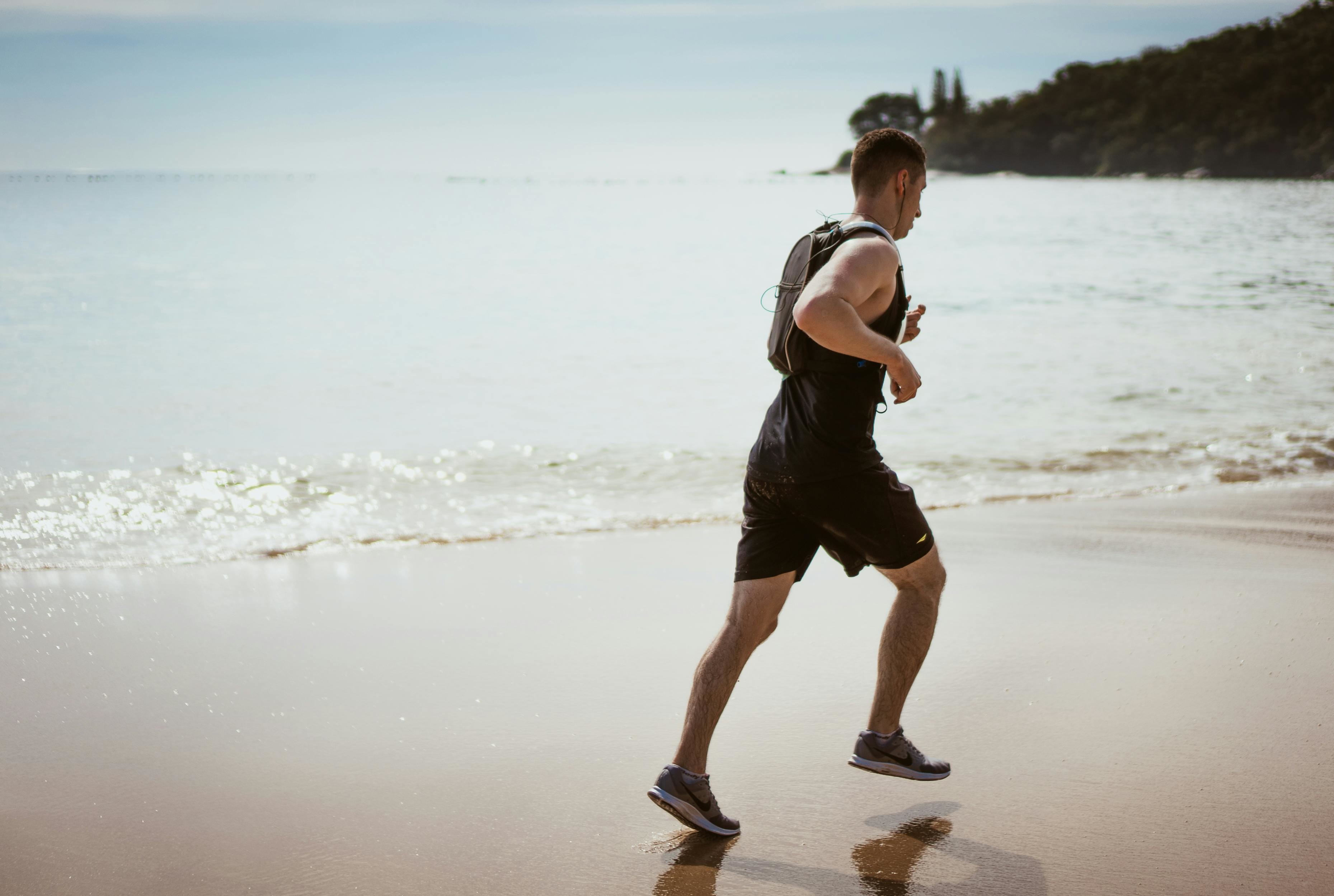
As a doctor of physical therapy, I’ve spent countless hours working with runners of all ages and capacities. Over the years, I’ve started to pick up on the overlapping patterns that lead to overuse and dysfunction in this dedicated population. And as a runner and former collegiate athlete myself, I understand the mental, physical, and emotional difficulties that come with hanging up your sneakers due to an injury.
As the race season really starts to ramp up in the Seacoast, I unfortunately start to see more and more runners in my office. Achilles tendonitis. Aching knees. Plantar fasciitis. Hip flexor pain and tightness. These issues typically don’t show up overnight, and often take their time to resolve as well. As the old saying goes, an ounce of prevention is worth a pound of cure…
That’s what inspired me to put together this month’s blog post. I’m hopeful that the advice below can help get you where you want to be, and keep you there for many years to come.

Keys to optimizing performance:
Whether you’re new to running or in the midst of training for your next marathon, it’s important to consider how your workouts can be more efficient and effective. These concepts give a general overview of ways you can maximize the positive impact your runs have on your health and performance.
Utilize the 80/20 rule
Popularized by Matt Fitzgerald, this rule helps with dosing your running intensity throughout the week. Based on this approach, 80% of your weekly training should focus on low intensity workouts to improve cardiovascular fitness and endurance, while the remaining 20% should focus on high intensity workouts to improve speed and stamina.
Find the right cadence
The rough average for optimal steps per min is 170-180bpm, which works out to 3 steps per second. Shorter quicker steps means less ground contact time, which helps to reduce the force of impact from each step. To do this, try utilizing a metronome, or search your desired BPM on Spotify to build out a playlist to match your chosen cadence.
Footstrike
Above all else, the most important piece is finding a running form that feels comfortable for you. Beyond that, it’s more about where and how your foot is hitting the ground in comparison to the rest of your body. It’s less important which part of your foot contacts the ground first (heel strike versus forefoot strike). Changing between these foot strike patterns can be a very difficult transition, and evidence suggests it doesn’t offer much benefit for running efficiency or injury prevention. Instead, emphasize your foot contacting the ground when it’s underneath your hips rather than out in front of you. Also, focus on soft and quiet ground contacts. A softer step is an indicator of a lower impact, more efficient stride.
Arm swing
Proper arm swing is crucial to counterbalance your legs and maintain forward momentum while running. You want to keep this motion to the sagittal plane (straight forward and backwards) with your arms compact to your body. Avoid expending extra energy by overextending, swinging across midline, or by clenching your fists
Nose breathing vs mouth breathing
This concept has become somewhat mainstream in the past decade due to James Nestor’s “Breathe” and James McKeon’s “The Oxygen Advantage”. This often-overlooked variable can make a big difference in your training and performance.
Benefits of nose breathing:
- Promotes a more controlled deliberate breath, which reduces the speed and volume of air reaching your lungs; hence enhancing the efficiency of oxygen uptake
- Increases lung capacity due to improved diaphragm engagement, leading to enhancements in endurance
- Increases tolerance for carbon dioxide over time, which trains the body to maintain optimal breathing patterns during exercise
- Improves maintenance of the oxygen/CO2 balance in your blood, which leads to reduced lactic acid build up, hence improving recovery and reducing muscle fatigue
- Enhances mental focus due to improved parasympathetic nervous system activity
- Reduces risk of respiratory issues due to nose naturally filtering and warming air before it enters the lungs
Useful tips for injury prevention:
Now that we’ve highlighted ways to make your running technique more efficient, let’s discuss how to optimize your programming to reduce your risk of injury over time. The best progress is made with consistent training, so let’s keep you on track.
Incorporate cross training
Variety is the spice of life! Having various modes of exercise throughout the week helps to train your body through different planes of motion. This helps to prevent overuse from one specific activity, and improves resiliency. Whether you add strength training, yoga, pilates, cycling, or a little bit of everything; your body will thank you.
Make steady changes in mileage
A common time for injuries to develop is when ramping up mileage. The strategies below are helpful to consider when structuring your programming:
Use of Intervals:
- These work well when just starting out, to give your body time to adjust
- Walk/run intervals, progressed weekly (such as Couch to 5K)
10% rule:
- This works best for higher mileage runners
- If you’re running 40 miles/week, don’t increase total mileage by >4 miles/week
Progressions based on number of runs per week
- This is a great strategy for short-mid distance runners, or when you’re just starting to run more consistently
- If you’re running 3 days/week, you can increase weekly mileage by up to 3 miles
Warm ups: what aspects are really important
Contrary to popular belief, your warm up doesn’t need to be lengthy or complicated. The goal of a warm up is simple: to prepare your body for the upcoming task, and assess how you’re feeling that day. Spending time on a warm up provides insight into how much you can handle during your workout. It’s helpful to have the same routine each time as a self check in, providing a moment of mindfulness and awareness to get in tune with your body. Be sure to incorporate single leg movements that emphasize coordination and control. By moving with intention and precision in your warm up, you prepare your body to fall into an easy rhythm during your run.
Sample warm up
- Single knee to chest stretch
- Marching matrix: (can use a light ~5lb weight in hands)
- March with push press
- March with cross body rotation
- March with overhead press
- March to SL RDL
- A-skips
- Gradual increase in pace from light jog to conversational pace over 5-10 minutes
Emphasize recovery
Sleep and nutrition are crucial pieces of the puzzle when it comes to injury prevention. Our bodies are constantly breaking down and regenerating our cells, which happens to a greater extent when we’re training regularly. It’s important that you fuel enough to meet these demands. Underfueling can have serious consequences and can set the scene for overuse and bone stress injuries
Footwear: what to wear and when to change
The general rule for mileage is to change out your shoes every 300-500 miles. An easy way to prolong the lifespan of your shoes is to rotate between a few pairs. The foam in the midsole of your shoes gets compressed while running, and this takes time to fully expand back to its prior capacity for absorption. By having multiple pairs to cycle through, it allows you to run on back to back days while always having a fresh pair ready to roll. You want similar specs between shoes, but can vary the level of cushion (more cushion is helpful for longer runs, less for speed work/intervals).
When determining what type of shoe to get, there are numerous variables to consider, such as heel to toe drop and the amount of stability/external support. There are stores such as Runner’s Alley in Portsmouth that can assist with selecting a shoe that’s the right fit for your anatomy and running mechanics.
If you’re currently a runner and are hoping to make a dramatic change to your shoe style (such as changing from a Hoka to a minimalist shoe), be cautious with making the change all at once. Your body will need time to adjust, and this is best done gradually (when the book “Born to Run” came out, I suddenly had a huge influx of runners and triathletes with lower body overuse injuries after making a sudden shift to minimalist footwear while maintaining their mileage).

Addressing injuries once they develop:
Even if you’ve been following your program to a T, eating well, making time for recovery, and prioritizing cross training, injuries still can happen. Below I’ve highlighted some important variables to consider if you’ve been noticing pain during or after your runs.
Don’t ignore the symptoms
When a small ache or pain starts to develop, it can be tempting to push through and hope it goes away. Maybe you’re working with a running coach or utilizing an online program, and don’t want to fall off track from your programming for an upcoming race. But ignoring these symptoms can make a mountain out of a molehill. When you feel pain, it’s your body’s way of trying to tell you something. Avoiding the reality of these communications can ultimately lead you down a path of regret and further injury.
Avoiding the rest/reinjury cycle
We’ve all been here before: you finally get into a good routine with running, and are seeing improvements with your endurance and stamina. Suddenly, you start to develop pain in your knee. So you take a few days off, and the pain resolves. But each time you add running back to your routine, the pain returns. And after each cycle, maybe it hurts a little bit more, and takes a few extra days to resolve. Even after taking a few weeks of rest, you can’t seem to kick the pain. At this rate, you’ve lost all your progress from your weeks of training prior to your injury.
When you’re dealing with an injury, it’s important to minimize setbacks by finding a form of exercise you can tolerate. Finding a movement, activity, pace, or duration of exercise you can perform without increased pain is crucial to help maintain your fitness level in the interim. This modified programming will look different for each individual based on their prior level of fitness and the severity of their injury. These modifications will allow your body the time it needs to heal, without resorting to lounging on the couch. This will help to maintain your capacity and reduce the risk of reinjury when you eventually return to your prior level of exercise.
Seeing the forest for the trees
If you’re dealing with recurrent injuries in one body region despite addressing it numerous times with exercises, manual therapy, or modalities, it may be time to look elsewhere. Pain returning in the same area despite thorough localized treatment is often an indicator of issues somewhere else in the kinetic chain.
So, if you’re dealing with recurrent knee pain, it may be related to an ankle mobility issue from that sprain you thought you fully recovered from in high school. Or if you’re dealing with recurrent foot pain, maybe it’s related to weakness in your hips, which impacts your coordination while you run. To put it plainly, the location where pain arises isn’t always the cause of the problem. Focusing on root cause approaches versus just addressing the sources of pain can be a game changer with ending this cycle.
Important aspects of a rehab program
When putting together a holistic rehab program, there are numerous variables to consider based on the individual, their injury, and their training goals. However, there are specific types of exercise that are important to include when preparing a runner to return to activity after an injury.
Targeted corrective exercises
- This may include mobility exercises to address an area of restriction, repeated motions to help with pain management, or a coordination drill to optimize your control. These are focused at optimizing function in areas that could use some improvement.
Isolated strengthening utilizing progressive overload
- This is a crucial component of rehab, especially after a muscle or tendon injury. It’s important to expose the affected area to progressively higher loads over time in order to build capacity and load tolerance.
Functional retraining
- This includes optimizing form for movements such as squatting, lunging, hinging, bending, and lifting. It’s important that we are able to move well before we move often or under higher loads
Plyometrics
- This helps to build explosive power, agility, and speed in preparation for returning to sports. It’s important to develop a tolerance for acceleration/deceleration, changes of direction, and jumping/landing in order to reduce the risk of reinjury.
Finding the right provider to help
If you’re having difficulty recovering from an injury despite making some of the changes suggested above, it’s probably time to seek assistance. Make sure to find a compassionate provider who’s willing to take the time necessary to understand your full picture, and build a program that’s sustainable and tailored to your goals.
If this information resonates with you and you’d like to get in touch, schedule a free consultation at Ebb and Flow Rehabilitation to get started.
Follow us on Facebook and Instagram for more content like this
Angelica Romeu is Doctor of Physical Therapy and the owner of Ebb and Flow Rehabilitation in Portsmouth New Hampshire






